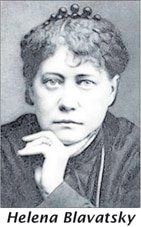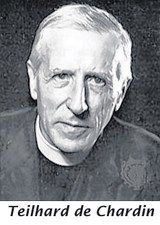This article is an abstract of a thesis. It provides an overview of evolution as a cosmological and metaphysical paradigm that seamlessly unites science with ‘spirituality’, in a manner that corrupts the truth.
Evolution is more than an alternative to the creation story. Evolution is not just a scientific concept; it is a spiritual worldview. This article is not by any means complete nor exhaustive; it is simply a broad overview of the topic of spiritual evolution, particularly its mysticism and esoteric applications to postmodern life, in both the culture at large and also the church.
Perfection
The full scope of evolution posits that there is a state of perfection that can be achieved, a telos (goal, purpose) of creation that will ultimately culminate in created matter being reabsorbed back into the ‘divine whole’, with man becoming a ‘god’ and attaining a higher plane of consciousness.
Man as ‘divine substance’ is a key tenet of this esoteric spirituality, teaching that having lost some of our ‘divine essence’ while entering the material existence, we are now evolving upwards into a gradual reabsorption into the divine, thus achieving divinity and perfection.
This idea has become integrated into both Judaism and heretical Christianity through the Kabbalah and other Gnostic sources. It claims that we are ‘co-creators’ with God.

It corrupts the doctrine of the Fall in the Garden of Eden. It trivialises, bypasses or neglects the cross of Christ (his shed blood for our sins and his resurrection) and forges a new pathway for ‘salvation’, in which man, through his own efforts (both spiritual and physical), must work towards a salvation that reunites him with ‘God’ in eternal bliss.
Thus the focus is not on man’s sin and our need for a Saviour, but on man’s spiritual quest for redemption. As such, the end goal does not anticipate Jesus’ second coming nor God’s day of judgement, but rather a paradisiac, nirvana state.
Eastern religions
The history of esoteric evolution is rooted in the influence of the eastern religions (Hinduism, Buddhism, Zoroastrianism, Greek humanism, etc.) on Jewish and Christian theology, from hundreds of years prior to Christ to our modern era.
At various times in church history, this influence would become more profound, as various historical cultures interacted or religions intermingled; and, as one looks at history, there is evidence of tides when this infusion of esoteric thought ebbed and flowed.
There is no one pivotal moment in church history, but rather significant nodules where a confluence is apparent. The extent to which some of these esoteric ideas — some stretching back thousands of years — have affected the modern-day, evangelical doctrine is the topic of dispute, debate and even denial.
Darwinism, with its more ‘scientific’ evolution, merely provides evidence of an underlying theoretical, philosophical and theological foundation of eastern mysticism.
This underlying foundation was already arising to prominence in European philosophy by the mid-1800s, and beginning to influence many of the academic disciplines. Besides impacting economic theory (Marx and Engels), it also originated or strongly impacted psychology, sociology, anthropology and a host of other emerging sciences and pseudo-sciences.

It found a happy correspondence with the rise of occult mysticism, especially theosophy. Furthermore, this esoteric evolution was beginning to affect the theology of the Protestant churches — not only the origins of man and creation, but also its soteriology and eschatology.
Teilhard de Chardin
The French Jesuit, anthropologist-philosopher-priest, Teilhard de Chardin, would become known as the ‘father’ of the modern mystical evolution now known as the New Age Movement.
Teilhard would propose that, just as mankind had evolved from apes (Darwinism), there would be an evolutionary leap, and mankind would abruptly emerge as a higher order species with a higher consciousness, which he called Homo noeticus (New man).
Teilhard was careful to couch all his words into a Christian-sounding terminology and fuse the two worldviews together into a new eschatology, in which man would achieve the level of a cosmic whole, a global mind.
Teilhard called this global mind the ‘noosphere’ (somewhat like a spiritual atmosphere — a psychic higher level). Teilhard also articulated the ‘omega point’ that would be an ultimate convergence of matter and consciousness — an eschatological climax.
Our fellow researcher Dr Martin Erdmann argues, with much historical contextual support, that the concept of modern evolutionism, especially as it has altered Christian theology, can be traced back to Gottfried Wilhelm Leibniz.
Leibniz, influenced by the German mystic Jacob Boehme, worked on a quasi-scientific model that God’s creation was evolving to a higher state of perfection. German mysticism spread out from the original core group of mystical thinkers: Schelling, Fichte, Goethe and, most significantly, Georg Hegel.

In his significant thesis titled Hegel and the hermetic tradition (2001), Glenn Magee argues that Hegel based his philosophy upon the tenets of occult Hermeticism and strove to weave these doctrines into a Christian paradigm based on an evolutionary teleology.
Theosophists and Marxists
In the 1800s, the theosophists, Madame Blavatsky and her cohorts (Annie Besant, Alice Bailey, et al) began to articulate a ‘new age’ on earth, based on the evolutionary rise of mankind.
They based their tenets on a combination of demonic transmissions and Hindu mysticism, foretelling a time in the near future when their secret ‘plan’ for a new world order could become an open conspiracy.
In 1980, Marilyn Ferguson, in her book The Aquarian conspiracy, officially launched this movement’s coming-out party. Ferguson would spell out this plan in much detail and describe its programme of taking over the major organs of society, especially science and education, for the furthering of mankind’s evolutionary path.
Of note is the fact that Ferguson emphasised a new mind, a new way of seeing and viewing reality, as necessary for this evolutionary leap.
Also, during the latter half of the 1800s, others would begin working on organising mankind into collectives. This implementation of esoteric evolution was structural and procedural, and there were many variations on this theme.
Marxism, with its emphasis on collectives, is an obvious example. It was felt that by placing men into groups, cells, units (or whatever else they were called), that it would facilitate and expedite this evolution to a higher level of being.
As such, this evolutionary mysticism is utopian, viewing mankind as malleable and believing that the ends justify the means. But the utilitarian means often became totalitarian, and this is the dark underside of all evolutionary mysticism.
The social engineers discovered that mankind can be forcibly coerced into small groups, communes, communities, tribes, work units, etc. in order to function, even though man’s base nature interfered in this utopic dream.
These experts learned that operant conditioning, specifically as it was refined by B.F. Skinner, was an effective method of inducing man to change his behaviour — rewarding compliance and penalising those who could not or would not learn.
Teleological goal
The generic term for this collective evolution is known as ‘general systems theory’. Its goal of organising mankind into structural units is ultimately for the purpose of facilitating a cosmic shift towards a unified whole.
A notable book detailing general systems theory as the means of human esoteric and structural evolution was authored by New Age leader Jeffrey S. Stamps. It is entitled Holonomy: a human systems theory (1980). Entire social systems could be reworked to facilitate conscious evolution, according to Stamps’ hierarchical models.
Barbara Marx Hubbard, noted New Age leader, also wrote prolifically on this topic of the evolution of consciousness of mankind, with a specific goal of creating an ‘Armageddon alternative’ to biblical prophecy. Here the teleological goal of esoteric evolution can be seen most clearly.
There were many other occultists, mystics, gurus and spiritual ‘visionaries’ who influenced societies at the turn of the last century. German society’s history was articulated in Richard Noll’s two books about Carl Jung, The Jung cult, and its sequel, The Aryan Christ. At the crux of these movements was man’s conscious evolution, which was re-cast in terms of spiritual enlightenment.
Jung envisioned psychotherapy as a rite of initiation into the occult mysteries, thus facilitating the evolution of consciousness. This then became a sub-theme of psychology throughout the twentieth century. In order for man to achieve nirvana as a collective whole, he would need to be put through transformative exercises (spiritual, psychological and sociological).
These methods were based on achieving altered states of consciousness, whether through meditation (contemplation) or the use of drugs, or even through intentional contact with the spirit world.
Sarah H. Leslie, B.Sc, M.Sc
To be concluded
Author’s note: Special thanks to Dr Martin Erdmann for his guidance in preparing this article.









